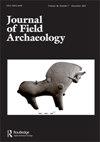大戟Kop的社会景观:在南部非洲有Forager的K2农民定居点
IF 1.5
1区 历史学
0 ARCHAEOLOGY
引用次数: 2
摘要
摘要:非洲南部全新世的觅食者是流动的、使用石器的、狩猎和采集的社区,他们生活在岩石避难所和临时营地的空地上。从公元1千年早期开始,农民群体迁移到南部非洲,将驯化的作物、牲畜和金属技术引入该地区,并居住在固定的家园中。这两个社区在物质文化和居住习惯方面的差异是明显的,并且在很大程度上是可以区分的。因此,通过对物质文化及其语境的分析来研究它们的互动是可能的。在这里,我们展示了南部非洲中部林波波河谷中部的大戟Kop的发现,其中包含了几条证据,表明在几个不同的文化标记确定的农民定居点内有觅食者的存在。我们的研究结果表明,该地区对接触的反应没有得到很好的记录,这为公元两千年初开始的岩石避难所中觅食者遗骸的减少和最终消失提供了可能的解释。本文章由计算机程序翻译,如有差异,请以英文原文为准。
Social Landscapes of Euphorbia Kop: A K2 Farmer Settlement with a Forager Presence in Southern Africa
ABSTRACT Holocene foragers in southern Africa were mobile, stone-tool-using, hunting and gathering communities that lived in rock shelters and in the open in temporary campsites. From the early 1st millennium a.d., farmer groups migrated into southern Africa and introduced domesticated crops, livestock, and metal technology into the region and lived in fixed homesteads. Differences in the material culture and residential habits of these two communities are distinct and largely differentiable. As such, studying their interactions is possible through the analysis of material culture and its context. Here, we present the findings from Euphorbia Kop in the middle Limpopo Valley of central southern Africa that contains several strands of evidence indicating a forager presence within a farmer settlement identified by several distinct cultural markers. Our findings demonstrate a response to contact not well recorded in the region that offers a possible explanation for the decline and eventual disappearance of forager remains in rock-shelter contexts beginning in the early 2nd millennium a.d.
求助全文
通过发布文献求助,成功后即可免费获取论文全文。
去求助
来源期刊

JOURNAL OF FIELD ARCHAEOLOGY
ARCHAEOLOGY-
CiteScore
4.60
自引率
5.30%
发文量
29
期刊介绍:
The Journal of Field Archaeology is an international, refereed journal serving the interests of archaeologists, anthropologists, historians, scientists, and others concerned with the recovery and interpretation of archaeological data. Its scope is worldwide and is not confined to any particular time period. Contributions in English are welcomed from all countries.
 求助内容:
求助内容: 应助结果提醒方式:
应助结果提醒方式:


